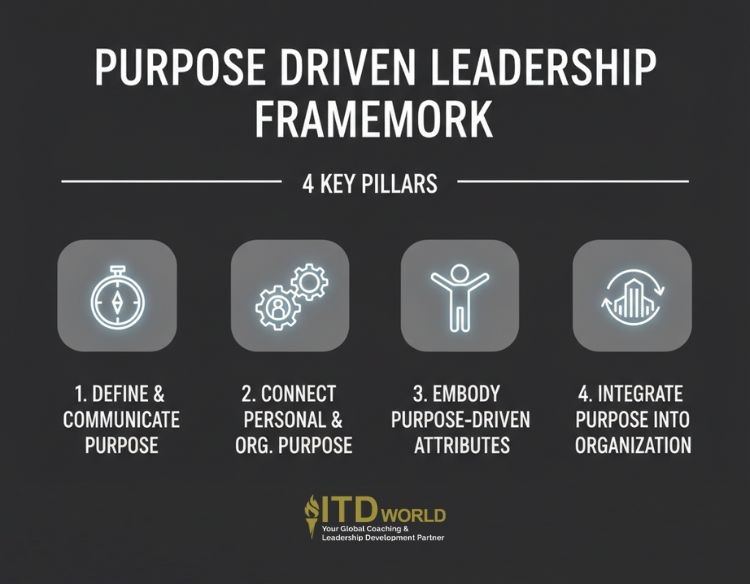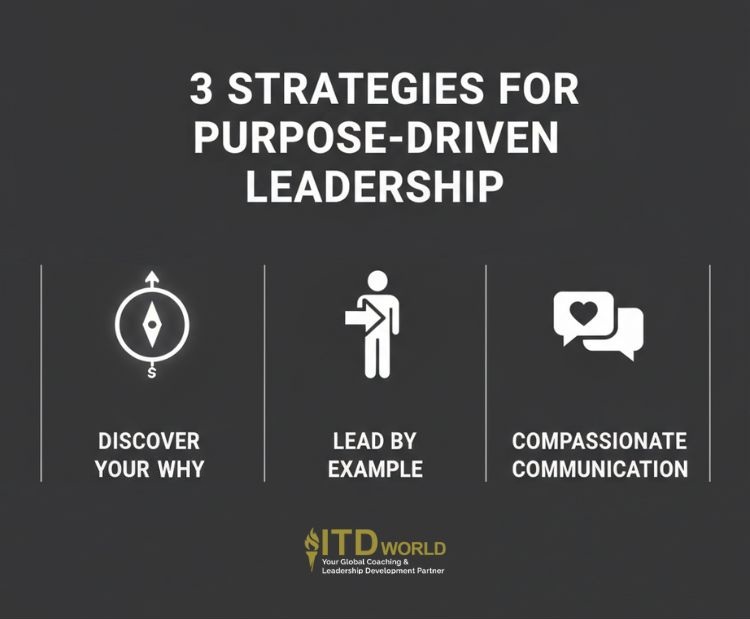People don’t buy what you do; they buy why you do it. And what you do simply proves what you believe.
Simon Sinek
A simple statement, yet it perfectly captures the essence of a potent force in modern business: purpose. Purpose-driven leadership is the strategic practice of moving beyond just what an organization does, to inspire and motivate teams with a clear and compelling “why”.
|
Author: Jonathan M. Pham |
Highlights
- Purpose-driven leadership is about consistently connecting a team’s daily tasks to a clear, compelling vision that goes beyond just profit. It shifts focus from tasks and metrics to a deeper human motivator: the need for meaning, which fosters commitment over mere compliance.
- This leadership style is a critical response to the modern workplace’s search for meaning, directly driving better engagement, retention, and performance. Purpose-driven organizations report higher rates of innovation and greater employee well-being, proving it is a pragmatic and powerful business strategy.
- Effective purpose-driven leadership requires a structured approach across four pillars: defining and constantly communicating the organizational purpose, connecting individual employee values to that purpose, the leader authentically embodying the purpose (“walking the talk”), and integrating the purpose into the entire organizational structure and culture.
- The primary challenges include overcoming the perception of a “purpose vs. profit” paradox (which is solved by framing purpose as a long-term profit driver), managing the risk of inauthenticity (which requires consistent action), and preventing burnout among passionate, mission-driven employees.
What is Purpose-driven Leadership?
Purpose-driven leadership (also referred to as “purposeful leadership” or “purpose based leadership”) is a leadership approach that revolves around consistently connecting a team’s daily work to a clear and compelling vision that transcends profit alone. It moves beyond traditional management’s focus on tasks and metrics to address a deeper, more powerful human motivator: the need for meaning.
Example: Let’s say a team is tasked with developing a new software feature.
- A task-driven manager might say, “We need to complete these 10 coding tasks by Friday to meet the project deadline.”
- A purpose-driven leader would frame the work differently: “The feature we are building this week will directly help our non-profit clients manage their volunteer schedules more efficiently, which means they can spend more time on their core mission. Our work has a real impact on their success.”
Characteristics of a purpose-driven leader:
- Visionary: They can see and articulate a clear and inspiring future that gives the team’s work meaning.
- Authentic: Their personal values are genuinely aligned with the vision they champion.
- Empathetic: They take the time to know what motivates their people on a human level and help connect individual aspirations to the team’s shared mission.
- Resilient: They are anchored by their belief in the purpose, which grants them the fortitude to navigate setbacks and keep the team focused during challenging times.
- etc.

Why is Purpose-driven Leadership Important?
- The modern search for meaning
The shift toward purpose-driven leadership is a direct response to a recent transformation in the workplace. In an era of constant disruption, people are re-evaluating the role of work in their lives, and what they are seeking has fundamentally changed.
According to a recent global study by McKinsey & Company, the vast majority of employees are looking for more purpose in their work. This trend is especially pronounced among younger generations. These cohorts are increasingly making career decisions based on their personal values, and they will not hesitate to leave organizations that lack a positive societal impact.
- Drives engagement, retention & performance
In today’s new landscape, where the war for talent is fought over meaning as much as money, a purpose-driven approach is no longer a “nice-to-have”; it is a critical tool for attracting the next generation of talent and unleashing their potential. In fact, a study published in the journal Administrative Sciences found that organizations with a clear purpose reported 30% higher levels of innovation and 40% greater employee retention.
- Boosts well-being
When leaders connect their team’s work to a meaningful mission, it fosters a sense of belonging and intrinsic motivation – which serves as a potent antidote to burnout. Those who feel their work has value are generally more resilient, more engaged, and report higher levels of overall well-being.
To sum it up, purpose-driven leadership is not just about “feeling good.” It is a pragmatic and powerful business strategy that creates the conditions for both people and the organization to thrive.
| Outcome | Conventional Leadership (Focus on “What”) |
Purpose-Driven Leadership (Focus on “Why”)
|
| Employee Motivation | Primarily Extrinsic (driven by salary, bonuses, or fear of negative consequences). |
Primarily Intrinsic (driven by a sense of meaning and personal growth).
|
| Employee Response | Compliance: Employees do what is required of them to meet their targets. |
Commitment: Employees are inspired to give their discretionary effort and go above and beyond.
|
| Long-Term Result | Transactional Loyalty: Employees stay as long as the compensation is competitive. |
Relational Loyalty: Employees stay because they believe in the mission and feel valued as people.
|

Is purpose-driven leadership motivational for teams
Purpose-driven Leadership Framework: 4 Key Pillars
Purpose-driven leadership is not just a philosophy; it involves a structured and actionable framework.
-
Define & communicate purpose
The foundational work of establishing a compelling “why” for the organization’s existence that goes beyond simply making a profit. It serves as the North Star that guides all other decisions.
Action: This involves articulating a specific purpose and ensuring the company’s mission (what it does) and vision (where it’s going) are in perfect alignment with it. The leader then becomes the “Chief Repeating Officer,” constantly communicating it and showing how day-to-day work contributes to it.
-
Connect personal to organizational purpose
A corporate purpose statement is only powerful if employees can see how their own work and personal values connect to it. As such, the leader’s role is to bridge the gap between the individual and the organization.
Action: Takes the time to understand what motivates one’s team members on a personal level – then work to align individual roles and responsibilities with the company’s larger mission, allowing each person to realize the direct line of sight between their contribution and the organization’s impact.
Example: One might say to a software engineer, “I know you’re passionate about creating accessible technology. The code you’re writing for this new feature will directly help users with visual impairments navigate our product more easily.”
-
Embody purpose-driven attributes
For a purpose to be credible, it must be consistently modeled by the leader. In other words, it is about “walking the talk” and leading with integrity.
Action: This requires one to practice authenticity, ensuring their actions always match their words. In addition, it demands empathy to understand the needs of the team and empowerment to give them the autonomy to contribute to the shared vision. These behaviors are what constitute the trust needed for the team to truly embrace the direction.
-
Integrate purpose into the organization
The final pillar is about hardwiring the purpose into the organization’s operating system – to move it from an idea into a daily reality.
Action: Builds a work culture where purpose-led behaviors are recognized and rewarded. Additionally, there should be a broader stakeholder focus, where decisions are made considering the impact on employees, customers, the community, and the environment – often associated with the “Triple Bottom Line” (People, Planet, Profit).
Example: This could involve changing performance review criteria to include an evaluation of how an individual contributed to the company’s social mission or establishing metrics to track the organization’s progress on its environmental and social goals.

Strategies for Becoming a Purpose-driven Leader
Before you can inspire others, you must first be grounded in your own – i.e. cultivating the foundational self-competencies of self-awareness and integrity that make authentic, purpose-driven leadership possible.
-
Discover your personal “why”
The first step involves deep self-reflection to clarify your core values and the unique impact you would like to have as a leader. Your personal purpose becomes the “true north” that guides every decision and action, especially during challenging times.
How-to: Ask yourself reflective questions such as:
- “What legacy do I want to leave behind through my work?”
- “When I am at my absolute best as a leader, what values am I honoring?”
- “Beyond my title, what is the unique contribution I would like to to make to my team and the whole organization?”
- etc.
Read more: Thoughtful Leadership – Why It Matters in Today’s Hectic World
-
Lead by example
Once you are clear on your “why,” the next important job is to “walk the talk.” People will not be inspired by a vision you declare, but by one you consistently demonstrate. In other words, you need to make your daily actions a visible reflection of your stated values.
Example: If your stated purpose involves a commitment to integrity, you must be the first to take ownership of a mistake. Instead of looking for blame when a project fails, say something like, “I am accountable for this outcome. Let’s focus on what we can learn from it together.”
-
Practice compassionate communication
Purpose-driven leadership is inherently human-centered. It requires developing the competency of empathy, compassion, and emotional intelligence to connect with your team members as whole people, not just as employees.
How-to: Shift the focus in conversations from transaction to connection. Practice deep listening to truly know the motivations and challenges of your team members.
Example: In a one-on-one meeting, a conventional manager might focus solely on project status (“What is the progress on Task X?”). A purpose-driven leader, on the other hand, asks questions that connect to the person: “What part of your work this week felt most meaningful to you?” or “What support do you need to feel more connected to our team’s mission?”
Read more: The Importance of Listening – How It Impacts Workplace Bonds & Facilitates Success

How Organizations May Foster a Purpose-driven Culture
- Embed purpose into the employee lifecycle
For a purpose to be authentic, it must be a consistent thread that runs through every stage of an employee’s journey, from their first interview to their performance reviews. In other words, it should be integrated into the core talent management processes.
Example: During the hiring process, go beyond skill-based questions and ask candidates, “What about our company’s mission resonates with you personally?” In performance reviews, create a section that evaluates not just what one achieved, but how their work contributed to the organization’s overarching vision.
- Provide development opportunities
An organization must invest in growing its leaders’ ability to connect with and lead from a place of purpose. This involves providing targeted learning and growth opportunities.
How-to: Offer coaching and mentoring programs that help leaders discover their own “why”, cultivate skills like storytelling, and learn how to conduct meaningful career conversations with their people.
- Foster a high-trust culture
A sense of purpose can only thrive in an environment of trust and psychological safety. The organization must create the conditions where individuals feel valued and empowered to contribute to the shared mission.
How-to: Establish transparent feedback mechanisms that allow for open dialogue. Recognize and reward not just top performers, but also the individuals and teams who consistently embody the company’s core values.
Example: Instead of only giving a financial bonus for hitting a sales target, try creating a “Purpose in Action” award to celebrate a team that went above and beyond to deliver on the company’s social or customer mission, even if it didn’t have an immediate financial payoff.
Read more: Continuous Learning Culture – The Blueprint for an Agile & Resilient Organization
Purpose-Driven Leadership in Action: Case Studies
A masterclass in action: Unilever’s “Purpose as strategy”
Few large corporations have embedded purpose into their core strategy as comprehensively as Unilever. Under the leadership of former CEO Paul Polman, the company’s “Performance with Purpose” vision became a global benchmark for how to align profit with a positive societal impact.
This was not a simple Corporate Social Responsibility (CSR) initiative; it became the central driver of its business strategy.
- Sustainability as a core driver: Unilever integrated environmental and social sustainability into its core operations, not as a cost center, but as a source of innovation and competitive advantage. The company’s Sustainable Living Plan set ambitious goals that guided everything from product development to supply chain management.
- Brand purpose activation: The philosophy was brought to life through its brands. Dove’s “Campaign for Real Beauty” challenged industry norms and established a powerful community around a purpose of promoting self-esteem. This marketing initiative created deep brand loyalty and significant business growth.
Spotlight on social entrepreneurship: Patagonia & TOMS
Purpose-driven leadership is also the foundational principle of the social entrepreneurship movement, where the business model itself is designed to solve a social or environmental problem.
- Patagonia
Founder Yvon Chouinard founded the company on a deep commitment to environmental activism – which guides every decision, from using sustainable materials to donating 1% of sales to environmental causes. In a now-legendary act of purpose over profit, Chouinard transferred ownership of the multi-billion-dollar company to a trust dedicated to fighting climate change. The result is not just a successful apparel company, but a fiercely loyal community of employees and customers who are deeply connected to the brand’s mission.
- TOMS Shoes
Founder Blake Mycoskie pioneered the revolutionary “One for One” business model. It was not a charity program added on to the business; the purpose—donating a pair of shoes for every pair sold—was the business. This simple, powerful mission revolutionized the concept of social entrepreneurship, proving that a for-profit company could have a profound social impact and inspiring a generation of purpose-driven ventures.
More case studies can be found here.
Challenges of Practicing Purpose-driven Leadership
- The “Purpose vs. Profit” paradox
One of the most common hurdles is the perception that focusing on a long-term vision will come at the expense of hitting short-term financial targets. Stakeholders, particularly investors or senior leaders, may view purpose-driven initiatives as a costly distraction from the “real work” of driving revenue.
Solution: The key is to reframe the conversation – by demonstrating that it is not an alternative to profit, but a long-term driver of it.
Example: A leader proposes investing in a more sustainable (but initially more expensive) supply chain, aligning with the company’s focus on environmental issues. To counter concerns about cost, they present a clear business case showing how the move will enhance brand reputation, attract a growing market of eco-conscious consumers, and ultimately lead to greater customer loyalty and profitability over the next three years.
- The risk of inauthenticity
When an organization’s stated purpose is not backed up by its actions, it causes deep cynicism among both employees and customers.
Solution: The only antidote is an unwavering commitment to authenticity and “walking the talk.” The purpose must be visibly integrated into the company’s decisions, behaviors, and priorities.
Example: A company declares that it aims to “empower its people.” However, it will do no good if leaders continue to micromanage, withhold information, and rarely ask for team input.
- Preventing burnout
Paradoxically, a highly compelling purpose is likely to lead to burnout. Passionate, mission-driven employees may become so dedicated to the cause that they overwork themselves, sacrificing their own well-being for the sake of the mission.
Solution: A leader must understand that a sustainable vision must address the well-being of the people pursuing it. They must actively protect their team from their own passion.
Example: A leader of a non-profit team, driven by an inspiring social mission, notices their staff are consistently working late and skipping breaks. They call for a team meeting and say, “Our mission is a marathon, not a sprint. We cannot serve our community effectively if we burn ourselves out. Let’s establish clear work-life boundaries and ensure we are all taking the time we need to rest and recharge.”

How to be a purpose-driven leader without burning out
Measuring the Impact of Purpose-Driven Leadership: Metrics to Keep Track of
By using a balanced scorecard of metrics, organizations can track the effectiveness of their leadership initiatives and demonstrate a clear return on investment.
- Employee & cultural metrics
These metrics serve as leading indicators to gauge how deeply a company’s purpose is integrated into the organization and its impact on its people. A critical one is Employee Engagement Scores, which should go beyond general satisfaction to specifically track questions related to purpose, such as employees finding their work meaningful or having a clear understanding of the company’s mission.
Furthermore, Retention and Turnover Rates are essential, as purpose-driven organizations tend to be “stickier” for talent; a lower voluntary turnover rate, particularly among high-potential employees, signals that people are committed and find meaning in their roles.
Finally, 360-Degree Feedback Scores are used to directly assess whether leaders exhibit purpose-driven behaviors, for example, by communicating the team’s vision and making decisions consistent with company values.
- Business & performance metrics
This set of metrics directly links the organization’s “why” to tangible business outcomes (“what”). Customer Loyalty and Advocacy are key, as customers who believe in a company’s vision are likely to become its most devoted champions; this is measured through metrics like the Net Promoter Score (NPS) and repeat business rates, alongside monitoring mission-related social media sentiment.
Additionally, companies can track their Innovation Rate by measuring the number of new ideas submitted and implemented, or the speed from idea inception to market launch.
- External & social impact metrics
These metrics are aimed at tracking the real-world difference an organization makes, affirming that its purpose authentically extends beyond mere profit generation. Environmental, Social, and Governance (ESG) Scores provide an objective, externally validated measure of the company’s commitment to social and environmental responsibility.
Beyond formal reporting, Brand Reputation metrics are crucial for monitoring the company’s standing in the public eye. This involves tracking media mentions, public opinion surveys, and rankings in “most respected” or “purpose-led” company lists.
Purpose-driven Leadership Quotes
It is not enough to be industrious; so are the ants. What are you industrious about?
Henry David Thoreau
He who has a “why” can bear almost any “how.”
Friedrich Nietzsche
When you are inspired by some great purpose, some extraordinary project, all your thoughts break their bonds: Your mind transcends limitations, your consciousness expands in every direction, and you find yourself in a new, great and wonderful world. Dormant forces, faculties and talents become alive, and you discover yourself to be a greater person by far than you ever dreamed yourself to be.
Patanjali
Purpose-driven Leadership Books
- Purpose Driven Leadership: Building and Fostering Effective Teams – by Brigette Tasha Hyacinth
A practical guide to building high-performing teams through authentic leadership.
Covers strategies for employee engagement, diversity, inclusion, and leadership styles that elevate team performance.
- Force for Good: How to Thrive as a Purpose-Driven Leader – by John Blakey
Explores the challenges and rewards of leading with purpose in a world focused on profit, people, and planet.
Offers tools for resilience, authenticity, and ethical decision-making.
Shortlisted for the Leadership Book of the Year Award 2024.
- Start with Why: How Great Leaders Inspire Everyone to Take Action – by Simon Sinek
Introduces the concept of the “Golden Circle” and emphasizes the importance of knowing your “why.”
A foundational read for understanding purpose as a driver of leadership.
- Conscious Leadership: Elevating Humanity Through Business – by John Mackey, Steve McIntosh, Carter Phipps
Co-authored by the founder of Whole Foods, the book blends business strategy with personal growth and ethical leadership.
- The Infinite Game – by Simon Sinek
Encourages leaders to adopt a long-term mindset focused on values, trust, and continuous improvement rather than short-term wins.
- Dare to Lead: Brave Work. Tough Conversations. Whole Hearts – by Brené Brown
Discusses vulnerability, courage, and empathy as essential traits of purpose-driven leaders.

Purpose-driven Leadership Training with ITD World
Developing the skills to lead with purpose is one of the most transformative journeys a leader can undertake. It requires a deep commitment to both personal self-discovery and the strategic alignment of your team. While the journey begins with intention, it is often accelerated and amplified with the guidance of an expert partner who can provide proven frameworks and a supportive learning environment.
At ITD World, we specialize in enabling leaders and organizations to cultivate the capabilities needed to lead with impact. Our programs are designed to move beyond theory and equip participants with the practical tools to build a more engaged and innovative organization.
- Coaching certifications (e.g. Certified Coaching & Mentoring Professional – CCMP): Our globally recognized coaching programs are designed to equip the essential competencies for leaders to connect their team members to a common vision and promote a high-performance culture.
- Senior Leadership Development Program (SLDP): This premier program is ideal for aligning your senior team around a shared organizational purpose and equipping them with the strategic skills to lead the entire enterprise forward.
Ready to lead with a resonating “why”? Contact ITD World today to learn more about our world-class training solutions!
Other resources you might be interested in:
- Servant Leadership: For Those Who Wish to Be First
- Transformational Leadership: From Incremental to Exponential
- Executive Leadership: A Guide to Developing Tomorrow’s Titans
- Leadership Branding: Crafting an Inspiring Personal Identity

